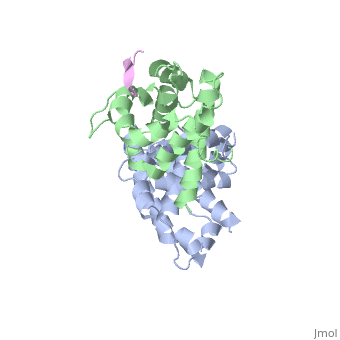Chad Sorenson sandbox 1
From Proteopedia
RETINOBLASTOMA PROTEIN
BACKGROUND
Retinoblastoma protein (pRb)is a regulatory protein that regulates cell growth. It does this by preventing the cell from replicating damaged DNA. It thus keeps the cell in the G1 phase and does not allow the cell to enter the S phase with damaged DNA. This protein is one that is commonly mutated in many types of cancer. The retinoblastoma gene that codes for the protein is a tumor suppressor gene, or a gene that protects a cell from one step on the path to cancer. One can tell early in one's life if they possess mutations in this gene because often mutations in this gene cause the person to develop retinoblastoma cancer, hence the name retinoblastoma. While retinoblastoma cancer is located in the eye, the protein is found in all cells in the human body. It is currently unknown why early mutations in this gene cause retinoblastoma cancer.
Retinoblastoma protein has two main domains ( and ). At the interface of these two domains, there is a pocket that is able to bind and inhibit E2F (transcription factor). You can see pRb bound to E2F . The structure on the bottom right shows pRb bound to E2F. Here, pRb is the green and blue structures. It is the same structure as above, but with added E2F sequences. The role of E2F is to promote the cell into the S phase. Since pRb binds E2F, then it inhibits the cell from entering the S phase. pRb is active when it is not phosphorylated, however when cyclin-dependent kinases (CDK) and cyclins phosphorylate pRb it inactivates the protein. Once it becomes phosphorylated, it releases E2F and then the cell can enter the S phase.
| |||||||||
| 1o9k, resolution 2.60Å () | |||||||||
|---|---|---|---|---|---|---|---|---|---|
| Related: | 1pjm, 1n4m, 1h24, 1ad6, 1h25, 1gh6, 1gux, 2aze | ||||||||
| |||||||||
| |||||||||
| Resources: | FirstGlance, OCA, RCSB, PDBsum | ||||||||
| Coordinates: | save as pdb, mmCIF, xml | ||||||||
EXPERIMENTAL OBSERVATIONS IN TUMORS
Several genetics studies have been done on the RB gene and on its affect on many different types of cancer. In retinoblastoma tumors, there is no evidence of any pRb in these tumor cells. Because of the absence of pRb, these cells have a very high change of becoming cancerous. It has been concluded that RB gene inactivation is universal in all retinoblastomas and that pRb is rapidly degraded in these tumors. The inactivation of the RB gene is universal in retinoblastomas, but it plays a factor in many other cancers as well. It has been shown that mutations in the Rb gene could lead to reduced levels of pRb in other cancers including: Small Cell Lung Carcinomas (SCLC), bladder, breast, and a few others.
About this Structure
1GUX is a 3 chains structure of sequences from Homo sapiens and Human papillomavirus. Full crystallographic information is available from OCA.
Reference
- Lee JO, Russo AA, Pavletich NP. Structure of the retinoblastoma tumour-suppressor pocket domain bound to a peptide from HPV E7. Nature. 1998 Feb 26;391(6670):859-65. PMID:9495340 doi:10.1038/36038
1. Horowitz, J. M., Park, S., Bogenmann, E., Cheng, J., Yandell, D., Kaye, F., Minna, J., Dryja, T., and Weinberg, R. (1990) Proc. Natl. Acad. Sci. Vol. 87, pp 2775-2779.
2. http://en.wikipedia.org/wiki/Retinoblastoma_protein
Page seeded by OCA on Mon Feb 16 14:09:11 2009



